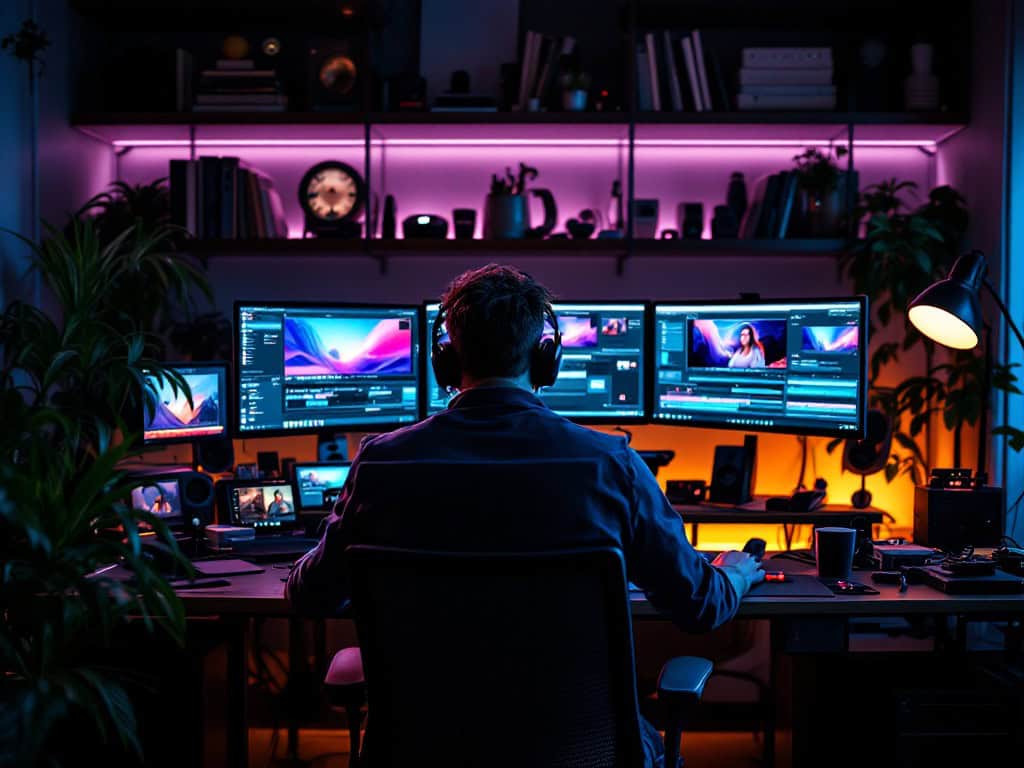The world of digital content is booming, and you know what’s at the heart of it? Video! It’s become essential for everything from YouTube channels to company websites. When I first started as a video editor, the sheer amount of work was a bit overwhelming, but it also meant there was a huge opportunity for anyone willing to learn the ropes. In this blog, I want to share my experience and advice on navigating the exciting world of freelance video editing. Whether you’re looking to hire an editor or become one yourself, I’ll cover everything from finding the right talent to succeeding in this competitive field. By the end, you’ll be ready to dive into the world of freelance video editing with the knowledge and strategies you need to make a real impact.
What Does a Freelance Video Editor Really Do?
Being a freelance video editor is about so much more than just knowing how to cut clips together. It’s about weaving a story, creating something that connects with viewers on an emotional level. The role goes beyond just the technical aspects; it’s about understanding the message and making sure it resonates. Unlike editors who work for a single company, freelancing gives me the freedom to choose projects that I find interesting and fulfilling. This flexibility is amazing for exploring my creativity, but it also means I need to be organized and able to adapt to different workflows. Finding that sweet spot between creative vision and technical skills is what makes a freelance video editor stand out. So, if this sounds like the career for you, remember that it’s a dynamic field that values both artistic talent and a strong understanding of editing techniques.
Must-Have Skills for Freelance Video Editors
Over time, I’ve learned that certain skills are non-negotiable for success as a freelance video editor. Of course, you need to be proficient in software like Adobe Premiere Pro and DaVinci Resolve, but what truly sets you apart is the ability to tell a captivating story through your edits. It’s the attention to detail, those subtle tweaks, that can elevate a project from good to outstanding. The world of video editing is constantly evolving, so staying updated with the latest trends and technologies is crucial. I make it a point to take online courses, follow industry experts, and engage with online communities like those on Reddit and LinkedIn. This continuous learning not only improves my skills but also keeps me competitive. If you’re serious about becoming a freelance video editor, focus on honing these skills and never stop learning. It will make all the difference in your journey.
Where to Find Freelance Video Editing Gigs
Finding work as a freelance video editor can seem daunting, but I’ve found some really effective strategies. Platforms like Upwork, Fiverr, and Freelancer have been game-changers for me. I made sure my profile on these sites was top-notch, showcasing my best work and highlighting what makes me unique. Having a strong portfolio is essential because potential clients often browse through many profiles quickly. Networking has also been incredibly valuable. Connecting with other professionals on LinkedIn has led to referrals and collaborations. Attending industry events, both online and in person, has helped me build relationships that go beyond just finding work. Remember, being active in the right communities can open doors to opportunities you won’t find advertised elsewhere. Additionally, exploring websites like Fiverr can provide more avenues to find freelance gigs. So, if you’re on the hunt for freelance video editing jobs, create a compelling online presence and don’t underestimate the power of networking. It’s all about connecting with the right people and showcasing your talent effectively.
Building a Portfolio That Shines
Creating a standout portfolio has been crucial to my success as a freelance video editor. I realized early on that how I presented my work was just as important as the work itself. My portfolio includes a mix of personal projects, client work, and collaborations, showcasing my versatility. For example, I included a case study where I transformed raw footage from a local event into a dynamic highlight reel, which really caught the eye of potential clients. I also recommend presenting your work in an engaging way. Short, captivating clips that highlight your editing style are more effective than lengthy videos. Adding a brief description to each project, explaining the context and your creative choices, can also make your work more relatable. By carefully curating my portfolio, I’ve been able to position myself as a skilled and versatile freelance video editor. If you’re building your portfolio, focus on quality, diversity, and storytelling. These elements will help you make a memorable impression.
Pricing Your Work as a Freelance Video Editor
Figuring out how much to charge for your services can be one of the trickiest parts of being a freelance video editor. It’s important to research industry standards, but remember that rates can vary widely based on your experience, the complexity of the project, and the client’s budget. Newcomers might start around $25-$50 per hour, while seasoned professionals can command $100 or more. When setting my rates, I consider the value I bring to each project. It’s not just about the hours I put in; it’s about my skills, creativity, and expertise. Transparency is key during negotiations. Clearly explaining your pricing helps build trust with clients. It’s also important to listen to their expectations and budget constraints. This allows for flexibility while ensuring you’re fairly compensated. Remember, negotiations should be a collaborative process, a way to find an agreement that works for everyone. As you gain experience, remember that confidence in your worth is essential. It will shine through in the quality of your work.
Best Practices for Working with Clients
Clear communication is absolutely essential when working with clients as a freelance video editor. Setting clear expectations from the start can prevent misunderstandings down the road. I begin each project with a detailed discussion to understand the client’s vision, deadlines, and feedback process. Managing feedback effectively is crucial. I often provide clients with a structured timeline for revisions to keep things on track. For instance, I once had a project where the client requested numerous changes that threatened to derail our schedule. By remaining calm and referring back to our agreed-upon timeline, I was able to prioritize the most important edits and maintain a positive working relationship. Building strong, long-term relationships with clients is about trust and transparency. When clients see that I’m invested in their project, they’re more likely to hire me again and recommend me to others. Remember, a happy client is your best advertisement. Prioritize clear communication and active listening; they are invaluable skills for any freelance video editor.
Essential Tools and Software for Video Editing
Over time, I’ve found certain tools and software to be essential for my work as a freelance video editor. Adobe Premiere Pro is my go-to for most projects because it’s powerful and user-friendly. However, I’ve also found that DaVinci Resolve has significantly enhanced my color grading abilities. To stay organized, especially when juggling multiple projects, I rely on project management tools like Trello. Stock footage sites and sound libraries are also invaluable resources, allowing me to enhance my projects with high-quality additional content. Investing in quality equipment is crucial. Upgrading to a faster computer and a calibrated monitor has made a huge difference in my workflow. Remember, the right software and equipment not only improve efficiency but also enhance the quality of your final product.
Navigating the Challenges of Freelance Video Editing
Freelancing as a video editor has its challenges, and I’ve definitely faced my fair share. One of the biggest hurdles is inconsistent income. It can feel like a rollercoaster, especially during slower months. Learning to budget effectively and having a financial safety net has been essential. Client management can also be tricky. I’ve encountered clients with constantly changing expectations, which can be stressful. Setting clear boundaries from the start and maintaining open communication helps minimize these issues. Finding a balance between work and personal life is another challenge. There have been times when I’ve been so absorbed in projects that I’ve neglected self-care. Prioritizing time management and taking breaks has made a world of difference. Building a support network has also been invaluable. Connecting with other freelance video editors has provided a space for sharing resources, advice, and encouragement. If you’re considering this path, remember that challenges are part of the journey. Embrace them, learn from them, and don’t hesitate to reach out to your community for support.
Conclusion: Embracing the Freelance Video Editing Journey
Looking back on my experience as a freelance video editor, I’m incredibly excited about the future. The insights and strategies I’ve shared, from crafting a compelling portfolio to mastering client communication, have been instrumental in my success. To anyone interested in becoming a freelance video editor, I encourage you to embrace your passion and don’t be afraid of the challenges that come with it. Adaptability is key in this ever-evolving industry. Staying current with trends and technologies will help you stand out. Whether you’re just starting or looking to grow your career, remember that every edit, every project, is a step toward mastery. So, dive in, harness the power of video, and make your mark in this dynamic and rewarding field. The possibilities are limitless. With dedication and creativity, you can thrive as a successful freelance video editor.
- How to Fire a Client: A Professional Guide for Business Success - November 22, 2024
- Freelance Video Editor: Essential Tips For A Successful Career - November 22, 2024
- Mastering Freelance Project Management for Success - November 22, 2024




